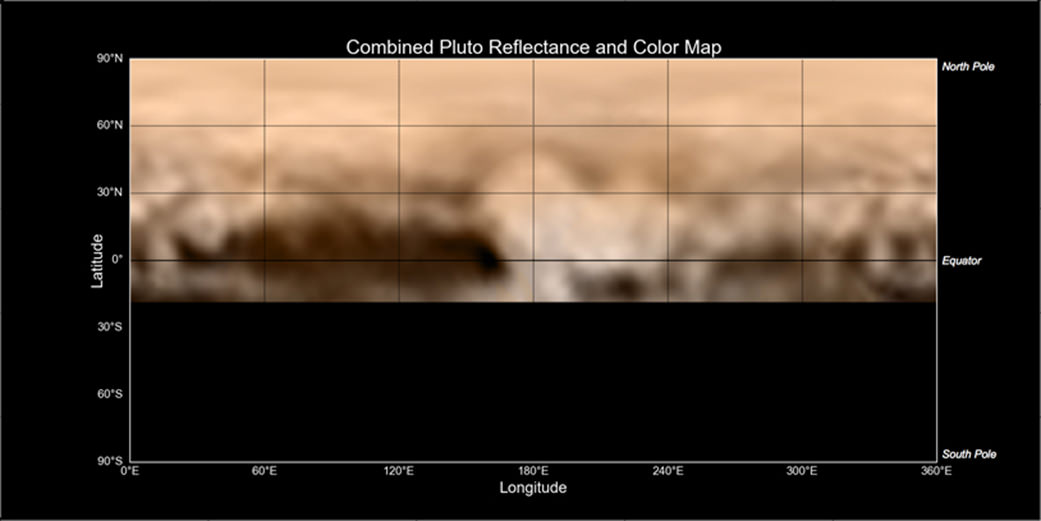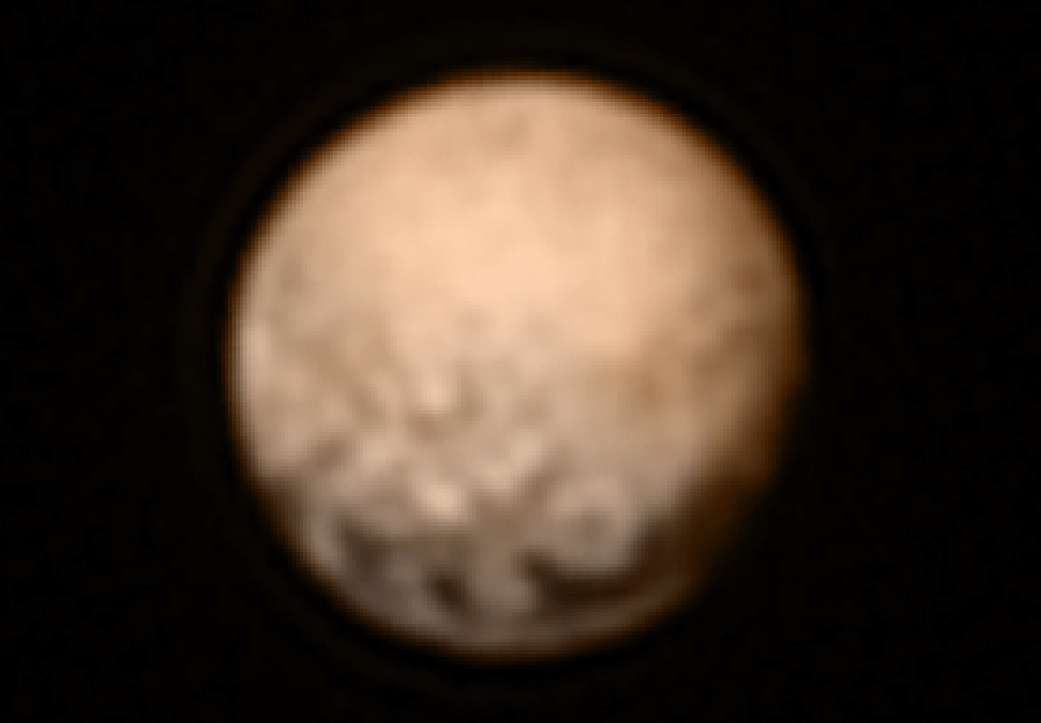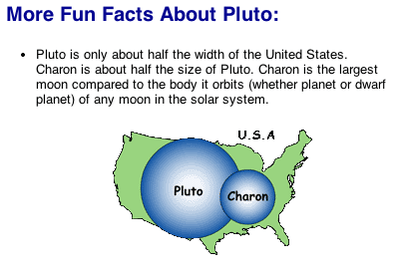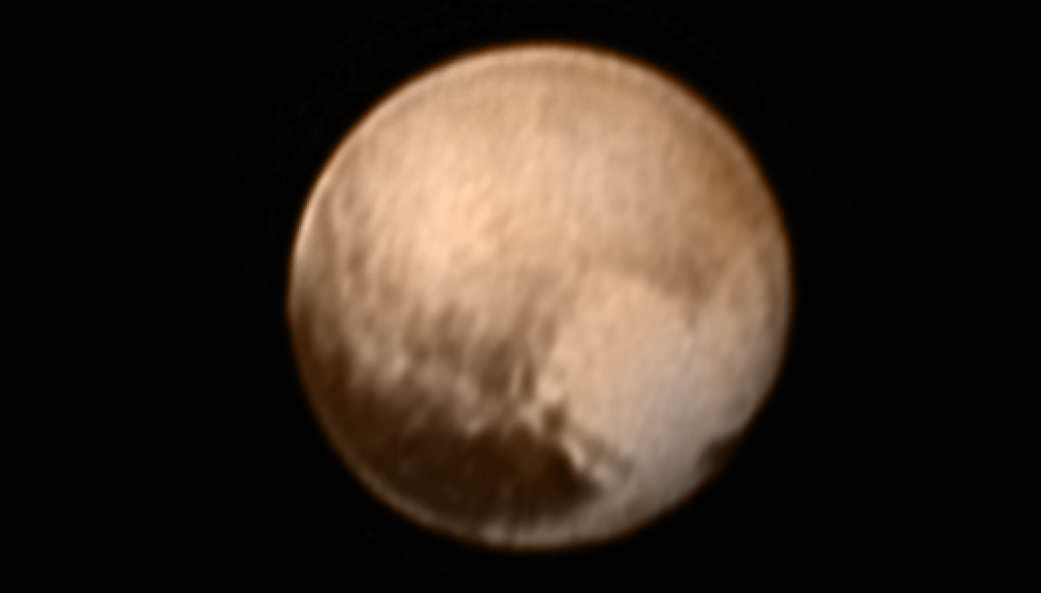The Huge Heart of Pluto
Pluto’s “Heart” is seen in this new image from New Horizons’ Long Range Reconnaissance Imager (LORRI) received on July 8, 2015 after normal science operations resumed following the scary July 4 safe mode anomaly that briefing shut down all science operations. It shows ‘the heart and the whale’ along Pluto’s equator. The LORRI image has been combined with lower-resolution color information from the Ralph instrument. Credits: NASA-JHUAPL-SWRI
Story updated[/caption]
Emotions are rising exponentially with the rousing revelation that Pluto has a huge ‘Heart’ as revealed in stunning new imagery received just today (July 8) from NASA’s New Horizons spacecraft – which has also officially started its intensive flyby campaign merely 5 days out from humanity’s history making first encounter with the last unexplored planet in our Solar System on Tuesday, July 14.
Notably, today’s image showing Pluto’s ‘heart-shaped’ surface feature proves that New Horizons is now fully back in business following the nail-biting July 4 weekend anomaly that unexpectedly sent the probe into a protective status known as ‘safe mode’ and simultaneously sent mission engineers and scientists scurrying to their computer screens to resolve the scary issues and recover the probe back to full operation – just in the nick of time.
The intriguing ‘heart’ is the brightest area on Pluto and “may be a region where relatively fresh deposits of frost—perhaps including frozen methane, nitrogen and/or carbon monoxide—form a bright coating,” say mission scientists.
While in ‘safe mode’ all science operations were temporarily halted for nearly three days as the spacecraft inexorably zooms towards mysterious Pluto and its quintet of moons for our first up close reconnaissance of the frigid world and the Kuiper Belt.
Read my earlier story from July 6 here detailing how the science team and NASA resolved the July 4 anomaly and restored New Horizons to normal operations with little time to spare for its one time only flyby of the other ‘Red Planet’.
The close encounter sequence last for 9 days and it will take 16 months to relay back the vast quantity of data to be collected.
The view of Pluto’s ‘Heart’ was taken by the Long Range Reconnaissance Imager (LORRI) when the spacecraft was just under 5 million miles (8 million kilometers) from Pluto, and is the first to be received back on Earth since the anxiety rush caused by the July 4 anomaly.
The heart covers nearly half of Pluto’s now well resolved disk.
Right beside the large heart-shaped bright area, which measures some 1,200 miles (2,000 kilometers) across, is another enigmatic and elongated equatorial surface on the left side informally dubbed ‘the whale.’
Mission scientists say ‘the whale’ is one of the darkest regions visible to New Horizons and it measures some 1,860 miles (3,000 kilometers) in diameter, making it about 50% wider that the ‘heart.’
Above ‘the whale and the heart’ lies Pluto’s polar region that images show is intermediate in brightness.
NASA also released another perspective view of ‘the whale and the heart’ as seen below.

This map of Pluto, made from images taken by the LORRI instrument aboard New Horizons, shows a wide array of bright and dark markings of varying sizes and shapes. Perhaps most intriguing is the fact that all of the darkest material on the surface lies along Pluto’s equator. The color version was created from lower-resolution color data from the spacecraft’s Ralph instrument. Credits: NASA-JHUAPL-SWRI
Be sure to keep this entire area in mind – as if your appetites haven’t been whetted enough already – because “this view is centered roughly on the area that will be seen close-up during New Horizons’ July 14 closest approach,” says NASA.
“The next time we see this part of Pluto at closest approach, a portion of this region will be imaged at about 500 times better resolution than we see today,” said Jeff Moore, Geology, Geophysics and Imaging Team Leader of NASA’s Ames Research Center, in a statement. “It will be incredible!”
With barely 5 days to go until the once-in-a-lifetime opportunity for a fast flyby encounter of the ever intriguing binary planet traveling at the far flung reaches of the solar system, last minute glitches are the last thing anyone needs.
Why? Because there are no second chances as New Horizons barrels towards the Pluto system at approximately 30,000 miles per hour (over 48,000 kilometers per hour), which forms a binary planet with its largest known moon – Charon.
“The New Horizons spacecraft and science payload are now operating flawlessly,” Alan Stern, New Horizons principal investigator, Southwest Research Institute, Boulder, Colorado, announced at the July 6 post anomaly media briefing.
The nature of Pluto’s features that may appear to resemble craters or volcanoes is not yet known.
“We should be very cautious in interpreting these features,” Stern told Universe Today.

New Horizons will swoop to within about 12,500 kilometers (nearly 7,750 miles) of Pluto’s surface and about 17,900 miles (28,800 kilometers) from Charon during closest approach at approximately 7:49 a.m. EDT (11:49 UTC) on July 14.
TThe probe was launched back on Jan. 19, 2006 on a United Launch Alliance Atlas V rocket on a 9 year voyage of over 3.6 billion miles (5.7 billion km).
“We are on our way to Pluto!” exclaimed Jim Green, director of Planetary Science, NASA Headquarters, Washington, at the July 6 news media briefing. “It’s really a historic time, fraught with many decisions and challenges on the way to the July 14 Pluto system encounter.”
“With Pluto in our sights, we’re going for the gold.”

The New Frontiers spacecraft was built by a team led by Stern and included researchers from SwRI and the Johns Hopkins University Applied Physics Laboratory (APL) in Laurel, Maryland. APL also operates the New Horizons spacecraft and manages the mission.
Stay tuned here for Ken’s continuing Earth and planetary science and human spaceflight news.



Still nobody seems to have actually said that 0° Long is (directly??) facing Charon and thus this heart-feature is right about opposite. Doesn’t seem accidental that two of the sticking features of the planet line up towards and away from the tidally locked planet!
These two features look more to do with the rotation of Pluto than the tidal lock.
Pluto actualy has two motions:
– axial rotation
– system’s gravity center orbit motion
the combination causes:
the Charon faced side to move slow
the Charon off-faced side to move fast
Just draw two circles, one for the faced and one for the off-faced side.
the radius would be:
r1 = distance to gravitational center = ~900 km
r2 = distance to [gc] + diameter of Pluto = ~ 3268 km
rotation speeds would be:
r1 * tau / (6.3 days * 24 hours) = ~37 km/h
r2 * tau / (6.3 days * 24 hours) = ~136 km/h
So tidal lock or rotation would mean the same for causing a difference.
The feature may have more to do with “revolution” than “rotation.” The heart may be ice from the atmosphere that “froze out” and fell to the surface while the two dwarfs were at the furthest point from the sun during their revolution around the sun.
Let’s see what happens when we get closer during the fly bye.
Hate to be nit picky, but Pluto is not the last dwarf planet to be explored in the solar system, but rather the latest. There are a few more dwarf planets left, most notably Eris. It would be foolish to assume, as most have that there are no more out there waiting to be discovered beyond the range of current technology. The gap past Neptune that marks the beginning of the Kuiper belt may have been cleared out by a large planet that could have receded in its orbit. There may well be some Neptune to Mars sized planets or smaller at a distant orbit waiting to be discovered as well as a plethora of Pluto sized dwarfs that many are already expecting to find. Based on extra-solar planet systems sun-sized stars can have large planets forming out much further than Neptune and rogue planets could have been captured in distant orbits from the birth cluster of the sun where stars were likely packed into close quarters. Such planets would have unpredictable orbits and would be very distant so impossible to find with current technology.
Yeah, there might be a continuous distribution of comets and rouge planets between us and our nearest stars. Very sparse, but maybe not at all as empty as presumed. Gaia might detect some distant Oort objects with microlensing. I don’t think they waste much telescope time looking for them, and it takes a lot for a non surveying telescope to identify Oort objects. But after the exoplanet boom we might, maybe, have an Oort cloud boom.
With luck, a Mars sized interstellar object might be useful for a far future space probe’s gravity assist, since such a rouge planet might have a relative speed of 100+ km/s.
If we now find tons of dwarf objects near Neptune then we should downgrade Neptune to dwarf planet.
“NASA’s New Horizons spacecraft – which has also officially started its intensive flyby campaign merely 5 days out from humanity’s history making first encounter with the last unexplored planet in our Solar System on Tuesday, July 14. (emphasis mine).
Soooo… Pluto is a planet again? Interesting. Any word on how it managed to regain its former status while somehow bypassing other, possibly more worthy objects, such as Eris, or Quaoar, e.g.? Or have we simply lumped the “dwarf” types in with the “regulars?” In that case, what about Haumea, Orcus, Sedna, et cetera? Have we explored them already and I just missed it?
My apologies, Dr. Kremer, and doubly so for my sarcasm, but logically speaking either Pluto is not a planet, or it is not “the last to be explored.”
ETA: Beat me to it, Greg. 😀 Of course, I assumed he meant “planets of which we are currently aware,” but that WAS an assumption on my part….
…………………wordswordswordswordswordswordswords………………………..
And allllll SO important!
Allow me to simplify. Whether or not one considers Pluto to be a “planet” (and I am not opposed, by the way), it simply cannot be “the last planet to be explored.” Either there are a number of other unexplored planets — the existence of which we are already well aware — or Pluto is not a planet in the first place.
Either situation renders Dr. Kremer’s statement false. I brought it up because his narrative flies in the face of known, established facts, and ignoring the facts in favor of a colorful narrative is a problem far more serious than whether or not one refers to Pluto as a “planet.”
— Or have we simply lumped the “dwarf” types in with the “regulars?”
It is silly to call them dwarfs when they are the GIANTS among the dwarf planets.
Dwarf planets ARE a subclass of planets. That was the intent of Dr. Alan Stern when he first coined the term in 1991. The four percent of the IAU that voted on this misused Stern’s term. In astronomy, dwarf stars are still stars, and dwarf galaxies are still galaxies. So too, dwarf planets are a subtype of “regulars” and should be classed with them .
Pluto never stopped being a planet. The problem is that the mainstream media has treated the controversial 2006 IAU vote by four percent of its members, most of whom are not planetary scientists but other types of astronomers, as fact rather than as what it really is–one interpretation in an ongoing debate.
That interpretation was immediately opposed in a formal petition by hundreds of professional astronomers led by New Horizons Principal Investigator Alan Stern. Those who signed his petition base their decision on support for a geophysical rather than dynamical planet definition. According to the geophysical planet definition, a planet is any non-self-luminous spheroidal body orbiting a star, free floating in space, or even orbiting another planet. If a celestial body is not a star itself and is large enough and massive enough to be squeezed into a round or nearly round shape by its own gravity, it is a planet. That means yes, Eris, Quaoar, Haumea, Orcus, Sedna, Makemake, and Ceres are planets; they are in the dwarf subclass of regular planets.
Pluto is the last unexplored planet dating to the beginning of the space age, when none of these worlds (other than Ceres) was known. Ceres is already being explored by the Dawn mission. Since the beginning of the space age, new solar system planets have been discovered and likely will continue to be discovered. Some suspect a Mars- or Earth-sized object may lurk as far from the Sun as the inner Oort Cloud.
“Pluto is the last unexplored planet dating to the beginning of the space age, when none of these worlds (other than Ceres) was known.”
That is a remarkably specific definition, one I’ve yet to hear from anyone except yourself. If Dr. Kremer had used it, I might have had less issue with his comment. Instead — and this was my issue all along — he made a statement that was demonstrably false on its face for sake of a good tag line.
Unfortunately, even for your definition, many of these (dwarf) planets were known to exist years before New Horizons ever left the launch pad. As such, the only way to truthfully call Pluto “the last” of anything is to artificially constrain the set of explored/unexplored planets to an era which ended more than a dozen years ago… something your definition does rather neatly, I must say.
It is difficult enough to describe & discuss the universe as it exists in all of its complexity and variety when we are all using the same definitions. It becomes almost impossible when those definitions become vague, fluid, or transient.
“Pluto: Last of the Planets” makes a great movie title, but it does not describe reality in this case
Are we getting excited yet? (intones a humble ‘Thank you’ for the recent mission recovery efforts!)
GO New Horizons!
The NASATV update noted that NH was moving along at within a mm/sec speed, 60×90 mile box, and trying to get within 100 sec of close approach now 4 days out from Pluto.